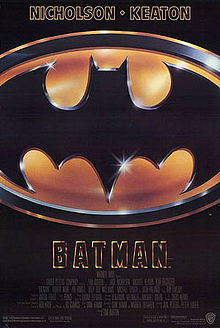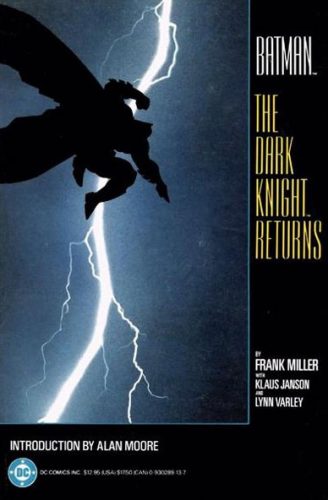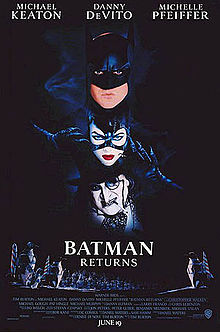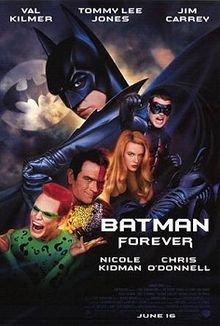 The 1989 release of Tim Burton’s BATMAN marked the birth of the modern blockbuster. I vividly remember those days: the excitement surrounding BATMAN’S release was downright feverish, it being (believe it or not) the only comic book themed movie on the market. Yes kids, there was once a time when a big budget film centered on a comic book character actually seemed fresh and innovative. Aside from the SUPERMAN flicks, which by 1989 had long since done themselves in, such films tended to be low budget affairs or comedies (as exemplified by MASTERS OF THE UNIVERSE and HOWARD THE DUCK).
The 1989 release of Tim Burton’s BATMAN marked the birth of the modern blockbuster. I vividly remember those days: the excitement surrounding BATMAN’S release was downright feverish, it being (believe it or not) the only comic book themed movie on the market. Yes kids, there was once a time when a big budget film centered on a comic book character actually seemed fresh and innovative. Aside from the SUPERMAN flicks, which by 1989 had long since done themselves in, such films tended to be low budget affairs or comedies (as exemplified by MASTERS OF THE UNIVERSE and HOWARD THE DUCK).
Another, even more important thing BATMAN had in its favor was an elaborate marketing campaign of a sort that’s quite common today but was unprecedented in 1989. Among other things, Warner Bros. took the unprecedented step of utilizing the San Diego Comic Convention—or, as it’s better known, Comic-Con—to build hype for the film (which is now par the course for just about any would-be blockbuster, comic book themed or not). That hype started over a year prior to BATMAN’S release, with the controversial revelation that Michael Keaton had been selected to star in the film, and continued throughout the opening months of ‘89, reaching a fever pitch upon the film’s release in June of that year. So great was the demand that Warner Bros. did something else new and unprecedented in releasing the film: it held midnight screenings on the Thursday before its release (another step that’s since become de rigueur for summer blockbusters).
I was among those who turned out for the Thursday midnight screenings. As a fan of Tim Burton’s earlier  films and Frank Miller’s DARK KNIGHT RETURNS, upon which this BATMAN was said to have been patterned, I was itching to experience the film, and wound up seeing it twice more in the following week. That’s despite the fact that I wasn’t too impressed with BATMAN; as with RETURN OF THE JEDI six years earlier, I figured the fault was with me and not the film, and so returned to it again and again in the hope that multiple viewings might improve my opinion. Alas, that didn’t occur with JEDI and nor with BATMAN, which seemed a dreary and empty-headed spectacle upon first, second and third viewing.
films and Frank Miller’s DARK KNIGHT RETURNS, upon which this BATMAN was said to have been patterned, I was itching to experience the film, and wound up seeing it twice more in the following week. That’s despite the fact that I wasn’t too impressed with BATMAN; as with RETURN OF THE JEDI six years earlier, I figured the fault was with me and not the film, and so returned to it again and again in the hope that multiple viewings might improve my opinion. Alas, that didn’t occur with JEDI and nor with BATMAN, which seemed a dreary and empty-headed spectacle upon first, second and third viewing.
Most everyone I knew felt the same way. Even Tim Burton himself publicly dismissed BATMAN as “boring,” but it made a shitload of money nonetheless, becoming the top grossing movie of the year (for which I certainly did my part) and one of the most lucrative films of all time. That’s great marketing!
Now, of course, eighties nostalgia has elevated the film considerably in the public mind. It’s currently viewed as a Hollywood masterpiece marred only by shitty sequels and the allegedly inferior reboots of director Christopher Nolan and star Christian Bale—who, according to one widely posted internet rant, are “owned” by Burton and Keaton.
I recently decided to rewatch BATMAN in the hope that time might have been kinder to the film. Quite simply: it hasn’t. The gorgeously noirish visuals of Burton and cinematographer Roger Pratt are certainly fun to look at and the rollicking Danny Elfman score mighty enjoyable to listen to, but if anything the film seems even more boring now than it was back in ‘89, bogged down in the early scenes by a superfluous political conspiracy subplot and in a later ones by a plethora of slow-moving action sequences. Michael Keaton gets very little to do outside of standing around and brooding, while Jack Nicholson as the Joker gets far too much screen time (a justification, apparently, for Nicholson’s bloated salary), and it’s all topped off with a wholly ridiculous HUNCHBACK OF NORTE DAME-esque climb to the top of a bell tower.
According to Tim Burton’s DVD audio commentary, on the set Nicholson questioned why the joker would make the abovementioned climb and Burton couldn’t come up with an answer. This exemplifies the make-it-up-as-you-go-along spirit of the production, in which the nuances of the script were bulldozed by the realities of big budget moviemaking, as well as the meddling of mega-producers John Peters and Peter Guber (the nonfiction HIT AND RUN by Nancy Griffin and Kim Masters alleges that at one point during BATMAN’S shoot Burton ran off the set crying due to Peters’ constant badgering).
Even more irritating in my view is the overall style, which strives for artificiality in all aspects. Note the highly stylized visual compositions and wildly baroque art direction by the late Anton Furst, as well as the patently unconvincing model work that Burton claims was meant to be intentionally cheesy a la his previous effort BEETLEJUICE. While I don’t entirely dismiss non-realistic filmmaking (I’m one of the few people who liked SPEED RACER), I tend to agree with the famous Fyodor Dostoevsky quote specifying that “The fantastic in art has its limits and laws. The fantastic must so merge with reality that you can almost believe it.”
 More evidence of BATMAN’S failure occurred in the form of its 1992 follow-up BATMAN RETURNS. In this film Burton was allowed to seize control away from the Peters boys and create something more in tune with his own sensibilities. This new BATMAN, he promised, would be wilder, more exciting and altogether better than its predecessor. While BATMAN RETURNS was indeed far more layered and inventive than the first film, and boasted a skin tight leather clad Michelle Pfeiffer as Catwoman (a definite plus), overall it was curiously lifeless and underwhelming–even more so in some respects than the first BATMAN. To me this would seem to confirm that Burton’s cartoony approach was inherently flawed.
More evidence of BATMAN’S failure occurred in the form of its 1992 follow-up BATMAN RETURNS. In this film Burton was allowed to seize control away from the Peters boys and create something more in tune with his own sensibilities. This new BATMAN, he promised, would be wilder, more exciting and altogether better than its predecessor. While BATMAN RETURNS was indeed far more layered and inventive than the first film, and boasted a skin tight leather clad Michelle Pfeiffer as Catwoman (a definite plus), overall it was curiously lifeless and underwhelming–even more so in some respects than the first BATMAN. To me this would seem to confirm that Burton’s cartoony approach was inherently flawed.
Further confirmation arrived in the string of lame superhero movies that followed in BATMAN’S wake and continued unabated throughout the nineties: DICK TRACY, THE ROCKETEER, DARKMAN, THE CROW, THE SHADOW, THE MASK, JUDGE DREDD, THE PHANTOM, SPAWN, BLADE and MYSTERY MEN. Like BATMAN, all those films were heavily stylized live action cartoons set in elaborate film noirish or sci fi netherworlds, and all but three (DARKMAN, THE CROW and BLADE) were eminently forgettable.
The same can be said for the Joel Schumacher helmed BATMAN FOREVER and BATMAN AND ROBIN, although I don’t believe they’re as opposed to the Burton films as many would have you b elieve. Where Schumacher’s BATMANS differed from Burton’s was in tone: studio execs blamed BATMAN RETURNS’ declining box office returns on the fact that it was “too dark” and sought a lighter shade for the subsequent films that was more in line with the ultra-campy BATMAN TV series from the sixties, which Schumacher readily provided. Fan outrage was swift and savage, particularly in the case of BATMAN AND ROBIN, which was so despised it inspired a “Give us Back Our Batman” petition among comic nerds. I’m not arguing that BATMAN FOREVER and BATMAN AND ROBIN are lousy, but I don’t believe they’re too far removed from BATMAN and BATMAN RETURNS, which like the latter films revel in campy artificiality.
elieve. Where Schumacher’s BATMANS differed from Burton’s was in tone: studio execs blamed BATMAN RETURNS’ declining box office returns on the fact that it was “too dark” and sought a lighter shade for the subsequent films that was more in line with the ultra-campy BATMAN TV series from the sixties, which Schumacher readily provided. Fan outrage was swift and savage, particularly in the case of BATMAN AND ROBIN, which was so despised it inspired a “Give us Back Our Batman” petition among comic nerds. I’m not arguing that BATMAN FOREVER and BATMAN AND ROBIN are lousy, but I don’t believe they’re too far removed from BATMAN and BATMAN RETURNS, which like the latter films revel in campy artificiality.
It’s become a matter of debate whether Sam Raimi’s ‘02 SPIDERMAN or Christopher Nolan’s ‘05 BATMAN BEGINS truly started the reality-based trend of modern comic book movies (FYI, there was initially supposed to be another Schumacher directed BATMAN sequel called BATMAN TRIUMPHANT, but it was cancelled). While SPIDERMAN was among the first to forgo the elaborate fantasy universes promoted by BATMAN and its offspring in favor of actual present day settings, Nolan’s film seemed downright mind-blowing when it first appeared, and refreshingly so: a BATMAN movie that didn’t play like a live action cartoon? What a concept! Makes me wonder how things might have played out if such an approach were taken back in 1989…
Of course these days, with comic book inspired films inundating movie theaters at a rate unheard of in any previous decade, it seems pointless to worry about who did what back in 1989. Indeed, the question now isn’t how to improve these films, but rather, how do we get rid of them?
